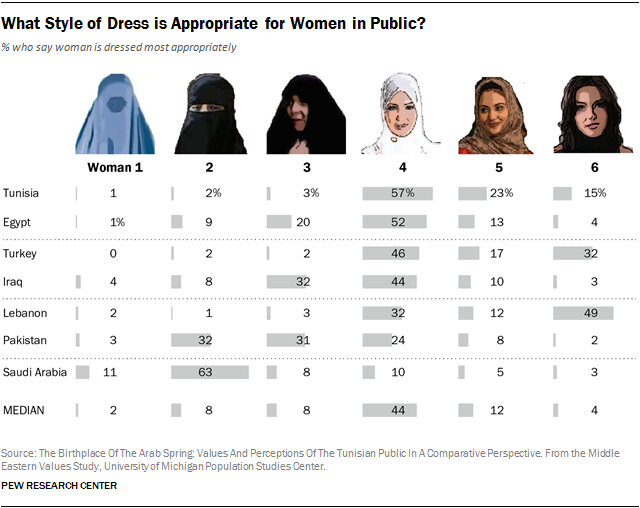From this graphic, you’d have to draw the conclusion that most people in Islamic nations are scandalized by the appearance of women’s hair:
An important issue in the Muslim world is how women should dress in public. A recent survey from the University of Michigan’s Institute for Social Research conducted in seven Muslim-majority countries (Tunisia, Egypt, Iraq, Lebanon, Pakistan, Saudi Arabia and Turkey), finds that most people prefer that a woman completely cover her hair, but not necessarily her face. Only in Turkey and Lebanon do more than one-in-four think it is appropriate for a woman to not cover her head at all in public.
The survey treated the question of women’s dress as a visual preference. Each respondent was given a card depicting six styles of women’s headdress and asked to choose the woman most appropriately outfitted for a public place. Although no labels were included on the card, the styles ranged from a fully-hooded burqa (woman #1) and niqab (#2) to the less conservative hijab (women #4 and #5). There was also the option of a woman wearing no head covering of any type.
Overall, most respondents say woman #4, whose hair and ears are completely covered by a white hijab, is the most appropriately dressed for public. This includes 57% in Tunisia, 52% in Egypt, 46% in Turkey and 44% in Iraq. In Iraq and Egypt, woman #3, whose hair and ears are covered by a more conservative black hijab, is the second most popular choice.
Update: Of course, no discussion of the oppression of women in other countries can be considered complete until we’ve managed to find an angle where Western culture is significantly worse:
Studies have found that the average woman in the UK spends £26,500 on her hair over her lifetime, with 25% of respondents saying they would rather spend money on their hair than food. And women don’t just spend serious money on their hair, they spend serious time on it. On average, British women spend just under two years of their lives styling their hair at home or in salons.
Whether it’s covered by a veil or coloured by Vidal Sassoon, hair is a feminist issue. Indeed, hair is so bound up with ideals of femininity that, to some degree, the measure of a woman is found in the length of her hair. In the semiotics of female sexuality, long hair is (hetero)sexual, short hair is non-sexual or homosexual, and no hair means you’re either a victim or a freak. When Natalie Portman shaved her head for a film role she summed up these stereotypes with the observation that: “Some people will think I’m a neo-Nazi or that I have cancer or I’m a lesbian.” But Portman also added: “It’s quite liberating to have no hair.”
[…]
In a sense, women’s hair in the west functions as it’s own sort of veil, one which most of us are unconsciously donning. The time and money women spend on their hair isn’t just the free exercise of personal preferences, it’s part of a broader cultural performance of what it means to be a woman; one that has largely been directed by men. Rather than fixating on what the veil means for Muslim women, then, we should probably spend a little more time thinking about our own homegrown veils. Because it’s still an unfortunate fact that, across the Muslim and non-Muslim world, women are often judged more by what is covering their head that what is in it.




